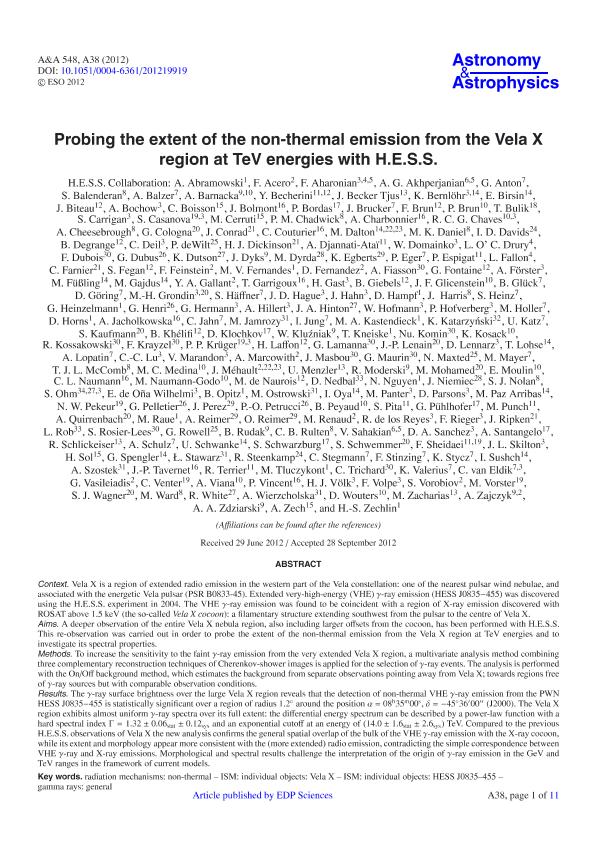Mostrar el registro sencillo del ítem
dc.contributor.author
Abramowski, A.
dc.contributor.author
Aharonian, Felix A.

dc.contributor.author
Akhperjanian, A. G.
dc.contributor.author
Anton, G.
dc.contributor.author
Balenderan, S.
dc.contributor.author
Balzer, A.
dc.contributor.author
Barnacka, A.
dc.contributor.author
Becherini, Y.
dc.contributor.author
Becker Tjus, J.
dc.contributor.author
Bernlöhr, K.
dc.contributor.author
Birsin, E.
dc.contributor.author
Bochow, A.
dc.contributor.author
Boisson, C.
dc.contributor.author
Bolmont, J.
dc.contributor.author
Boisson, C.
dc.contributor.author
Bolmont, J.
dc.contributor.author
Brun, P.
dc.contributor.author
Brun, F.
dc.contributor.author
Casanova, S.
dc.contributor.author
Cerruti, M.
dc.contributor.author
Chadwick, P.M.
dc.contributor.author
Charbonnier, A.
dc.contributor.author
Chaves, R.C.G.
dc.contributor.author
Cheesebrough, A.
dc.contributor.author
Cologna, G.
dc.contributor.author
Medina, Maria Clementina

dc.date.available
2018-03-26T14:28:44Z
dc.date.issued
2012-12
dc.identifier.citation
Abramowski, A.; Aharonian, Felix A.; Akhperjanian, A. G.; Anton, G.; Balenderan, S.; et al.; Probing the extent of the non-thermal emission from the Vela X region at TeV energies with H.E.S.S.; EDP Sciences; Astronomy and Astrophysics; 548; 12-2012
dc.identifier.issn
0004-6361
dc.identifier.uri
http://hdl.handle.net/11336/39888
dc.description.abstract
Context. Vela X is a region of extended radio emission in the western part of the Vela constellation: one of the nearest pulsar wind nebulae, and associated with the energetic Vela pulsar (PSR B0833-45). Extended very-high-energy (VHE) γ-ray emission (HESS J0835-455) was discovered using the H.E.S.S. experiment in 2004. The VHE γ-ray emission was found to be coincident with a region of X-ray emission discovered with ROSAT above 1.5 keV (the so-called Vela X cocoon): a filamentary structure extending southwest from the pulsar to the centre of Vela X. Aims. A deeper observation of the entire Vela X nebula region, also including larger offsets from the cocoon, has been performed with H.E.S.S. This re-observation was carried out in order to probe the extent of the non-thermal emission from the Vela X region at TeV energies and to investigate its spectral properties. Methods. To increase the sensitivity to the faint γ-ray emission from the very extended Vela X region, a multivariate analysis method combining three complementary reconstruction techniques of Cherenkov-shower images is applied for the selection of γ-ray events. The analysis is performed with the On/Off background method, which estimates the background from separate observations pointing away from Vela X; towards regions free of γ-ray sources but with comparable observation conditions. Results. The γ-ray surface brightness over the large Vela X region reveals that the detection of non-thermal VHE γ-ray emission from the PWN HESS J0835-455 is statistically significant over a region of radius 1.2° around the position α = 08 h35m00s, δ = - 45°36′00′′ (J2000). The Vela X region exhibits almost uniform γ-ray spectra over its full extent: the differential energy spectrum can be described by a power-law function with a hard spectral index Γ = 1.32 ± 0.06stat ± 0.12sys and an exponential cutoff at an energy of (14.0 ± 1.6stat ± 2.6sys) TeV. Compared to the previous H.E.S.S. observations of Vela X the new analysis confirms the general spatial overlap of the bulk of the VHE γ-ray emission with the X-ray cocoon, while its extent and morphology appear more consistent with the (more extended) radio emission, contradicting the simple correspondence between VHE γ-ray and X-ray emissions. Morphological and spectral results challenge the interpretation of the origin of γ-ray emission in the GeV and TeV ranges in the framework of current models. © ESO, 2012.
dc.format
application/pdf
dc.language.iso
eng
dc.publisher
EDP Sciences

dc.rights
info:eu-repo/semantics/openAccess
dc.rights
Atribución-NoComercial-CompartirIgual 2.5 Argentina (CC BY-NC-SA 2.5 AR)
dc.rights.uri
https://creativecommons.org/licenses/by-nc-sa/2.5/ar/
dc.subject
Radiation Mechanisms
dc.subject
Vela X (Pulsar)
dc.subject
Hess J0835–455
dc.subject
Gamma Rays
dc.subject
Non Thermal Mechanisms
dc.subject.classification
Astronomía

dc.subject.classification
Ciencias Físicas

dc.subject.classification
CIENCIAS NATURALES Y EXACTAS

dc.title
Probing the extent of the non-thermal emission from the Vela X region at TeV energies with H.E.S.S.
dc.type
info:eu-repo/semantics/article
dc.type
info:ar-repo/semantics/artículo
dc.type
info:eu-repo/semantics/publishedVersion
dc.date.updated
2017-05-15T17:05:04Z
dc.journal.volume
548
dc.journal.pais
Francia

dc.journal.ciudad
Paris
dc.description.fil
Fil: Abramowski, A.. Universitat Hamburg; Alemania
dc.description.fil
Fil: Aharonian, Felix A.. Max Planck Institut Fur Kernphysik; Alemania
dc.description.fil
Fil: Akhperjanian, A. G.. National Academy Of Sciences Of The Republic Of Armenia; Armenia. Yerevan Physics Institute; Armenia
dc.description.fil
Fil: Anton, G.. Universitat Erlangen-Nuremberg; Alemania
dc.description.fil
Fil: Balenderan, S.. University Of Durham; Reino Unido
dc.description.fil
Fil: Balzer, A.. Universitat Erlangen-Nuremberg; Alemania
dc.description.fil
Fil: Barnacka, A.. CEA Saclay; Francia
dc.description.fil
Fil: Becherini, Y.. Université Paris Diderot - Paris 7; Francia
dc.description.fil
Fil: Becker Tjus, J.. Ruhr Universität Bochum; Alemania
dc.description.fil
Fil: Bernlöhr, K.. Max Planck Institut Fur Kernphysik; Alemania
dc.description.fil
Fil: Birsin, E.. Humboldt-universitat Zu Berlin; Alemania
dc.description.fil
Fil: Bochow, A.. Max Planck Institut Fur Kernphysik; Alemania
dc.description.fil
Fil: Boisson, C.. Université Paris Diderot - Paris 7; Francia
dc.description.fil
Fil: Bolmont, J.. Max Planck Institut Fur Kernphysik; Alemania
dc.description.fil
Fil: Boisson, C.. Université Paris Diderot - Paris 7; Francia
dc.description.fil
Fil: Bolmont, J.. Universite Pierre et Marie Curie; Francia
dc.description.fil
Fil: Brun, P.. Cea Saclay;
dc.description.fil
Fil: Brun, F.. Laboratoire Leprince-ringuet; Francia
dc.description.fil
Fil: Casanova, S.. Max Planck Institut Fur Kernphysik; Alemania
dc.description.fil
Fil: Cerruti, M.. Université Paris Diderot - Paris 7; Francia
dc.description.fil
Fil: Chadwick, P.M.. University Of Durham; Reino Unido
dc.description.fil
Fil: Charbonnier, A.. Universite Pierre et Marie Curie; Francia
dc.description.fil
Fil: Chaves, R.C.G.. Cea Saclay; Francia. Max Planck Institut Fur Kernphysik; Alemania
dc.description.fil
Fil: Cheesebrough, A.. University Of Durham; Reino Unido
dc.description.fil
Fil: Cologna, G.. Landessternwarte Heidelberg; Alemania
dc.description.fil
Fil: Medina, Maria Clementina. Cea Saclay; Francia. Provincia de Buenos Aires. Gobernación. Comisión de Investigaciones Científicas. Instituto Argentino de Radioastronomía. Consejo Nacional de Investigaciones Científicas y Técnicas. Centro Científico Tecnológico Conicet - La Plata. Instituto Argentino de Radioastronomía; Argentina
dc.journal.title
Astronomy and Astrophysics

dc.relation.alternativeid
info:eu-repo/semantics/altIdentifier/url/http://www.aanda.org/articles/aa/abs/2012/12/aa19919-12/aa19919-12.html
dc.relation.alternativeid
info:eu-repo/semantics/altIdentifier/doi/http://dx.doi.org/10.1051/0004-6361/201219919
Archivos asociados
